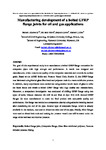Manufacturing and development of a bolted GFRP flange joint for oil and gas applications
| dc.contributor.author | Aljuboury, M | |
| dc.contributor.author | Rizvi, MJ | |
| dc.contributor.author | Grove, S | |
| dc.contributor.author | Cullen, Richard | |
| dc.date.accessioned | 2021-08-09T10:45:07Z | |
| dc.date.available | 2021-08-09T10:45:07Z | |
| dc.date.issued | 2021-01-10 | |
| dc.identifier.issn | 0954-4054 | |
| dc.identifier.issn | 2041-2975 | |
| dc.identifier.uri | http://hdl.handle.net/10026.1/17446 | |
| dc.description.abstract |
<jats:p> The goal of this experimental study is to manufacture a bolted GFRP flange connection for composite pipes with high strength and performance. A mould was designed and manufactured, which ensures the quality of the composite materials and controls its surface grade. Based on the ASME Boiler and Pressure Vessel Code, Section X, this GFRP flange was fabricated using biaxial glass fibre braid and polyester resin in a vacuum infusion process. In addition, many experiments were carried out using another mould made of glass to solve process-related issues. Moreover, an investigation was conducted to compare the drilling of the GFRP flange using two types of tools; an Erbauer diamond tile drill bit and a Brad & Spur K10 drill. Six GFRP flanges were manufactured to reach the final product with acceptable quality and performance. The flange was adhesively bonded to a composite pipe after chamfering the end of the pipe. Another type of commercially-available composite flange was used to close the other end of the pipe. Finally, blind flanges were used to close both ends, making the pressure vessel that will be tested under the range of the bolt load and internal pressure. </jats:p> | |
| dc.format.extent | 095440542198951-095440542198951 | |
| dc.language | en | |
| dc.language.iso | en | |
| dc.publisher | SAGE Publications | |
| dc.title | Manufacturing and development of a bolted GFRP flange joint for oil and gas applications | |
| dc.type | journal-article | |
| dc.type | Journal Article | |
| plymouth.issue | 9 | |
| plymouth.volume | 235 | |
| plymouth.publication-status | Published | |
| plymouth.journal | Proceedings of the Institution of Mechanical Engineers, Part B: Journal of Engineering Manufacture | |
| dc.identifier.doi | 10.1177/0954405421989517 | |
| plymouth.organisational-group | /Plymouth | |
| plymouth.organisational-group | /Plymouth/Faculty of Science and Engineering | |
| plymouth.organisational-group | /Plymouth/REF 2021 Researchers by UoA | |
| plymouth.organisational-group | /Plymouth/REF 2021 Researchers by UoA/UoA12 Engineering | |
| plymouth.organisational-group | /Plymouth/Users by role | |
| plymouth.organisational-group | /Plymouth/Users by role/Academics | |
| dcterms.dateAccepted | 2020-12-10 | |
| dc.rights.embargodate | 2021-10-2 | |
| dc.identifier.eissn | 2041-2975 | |
| dc.rights.embargoperiod | Not known | |
| rioxxterms.versionofrecord | 10.1177/0954405421989517 | |
| rioxxterms.licenseref.uri | http://www.rioxx.net/licenses/all-rights-reserved | |
| rioxxterms.licenseref.startdate | 2021-01-10 | |
| rioxxterms.type | Journal Article/Review |


